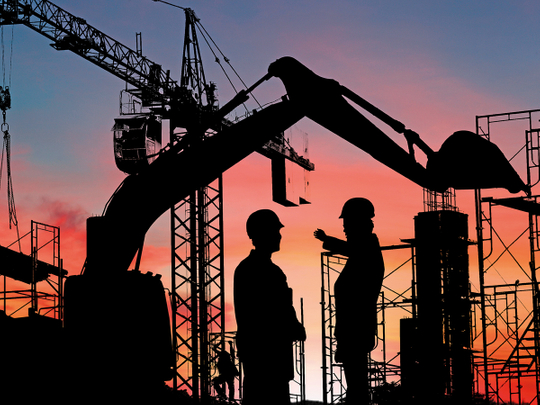
Poor air quality is the fourth-highest cause of death worldwide, according to the WHO. But while road transport has attracted most attention, less reported is the contribution of other polluters to the problem, particularly construction sites, which are responsible for damaging particulate and nitrogen oxide emissions, with the vast majority coming from the diesel diggers, generators and other machines operating on sites.
However, of late, construction equipment (CE) manufacturers are trying to help clean up with innovative green machines that emit far less smoke and offer greater fuel efficiency.
“The issue of construction pollution is an extremely important one that has been neglected across the region,” says Avin Gidwani, CEO of BNC Network, a construction intelligence platform. “Pushing for environment-friendly construction equipment is essential as Middle Eastern cities mature and focus on not only on speed, efficiency and cost of construction but also its overall impact on society."

Pushing for environment-friendly construction equipment is essential as Middle Eastern cities mature and focus on not only on speed, efficiency and cost of construction but also its overall impact on society.
Fuel efficiency
With the global construction industry growing and the drive towards lower emissions gaining traction, CE manufacturers announced many sustainable alternatives this year.
Leading the charge is Volvo, which last year trialled a prototype hybrid excavator that generates electric power from the downswing of its boom arm. In 2018, the Swedish company unveiled a smart hydraulic hybrid excavator, currently just a concept, that delivers significant improvements in fuel efficiency.
Furthermore, a hybrid, fully electric construction equipment has been deployed by Volvo and Skanska as part of a new project, Electric Site, to test the viability of an emission-free quarry. With a fleet of eight HX2 autonomous, battery-electric load carriers, Volvo expects up to a 95 per cent reduction in carbon emissions.
With 68 per cent of the world population projected to live in urban areas by 2050, according to a UN report, this means additional pressure in the construction industry, fully-electric and hybrid machines are set to take construction to a new level to cut carbon.
In April, Wacker Neuson, which has a whole zero-emissions line of machines, debuted its first fully electric, battery-powered EZ17e compact excavator to keep emissions and noise to a minimum, but delivering the same power and performance as gasoline-powered models, the company claims.
In March, JCB made company history with the unveiling of its first-ever electric excavator, the zero-emissions JCB 19C-1 E-TEC. With no daily checks of coolant and engine oil levels required, the company claims, the machine works quicker than its diesel counterpart.
Similarly, to meet increasing global environmental concerns, Komatsu, which developed the world’s first commercial hybrid excavator in 2008, launched its new HB215LC-3 hybrid excavator, offering significant fuel savings and reduced CO2 emissions.
Meanwhile, banishing any fears that hybrid machines might be less effective than entirely diesel-powered ones, Caterpillar launched its new electric drive 988K XE wheeled loader, which offers 25 per cent greater overall efficiency than the company’s diesel-powered 988K loader.
Said to be another first for the sector, Ausa introduced the D100AHA, an electric prototype dumper.
Turning to look more at the hybridisation of larger-scale construction equipment, as the development of hybrid- and electric-drive vehicles progresses, Dana is testing compact, fully-
integrated drive systems consisting of motors, gearboxes, power electronics and thermal-management products.
Eco-friendly equipment
Since many construction workers die from cancers caused by exposure to diesel fumes, firms such as Off Grid Energy in the UK developed products that turn traditional diesel generators, responsible for an estimated 25 per cent of site emissions, into hybrid machines, thus reducing fuel consumption by around 60 per cent.
In the UAE, top tier contractors are looking at options to increase the efficiency of their on-site equipment that relies on powerful diesel engines, by using biofuel, says Michael Boyle, Senior Sustainability Consultant at AESG.

There are now suppliers in the market offering hybrid solar-diesel-battery power systems to reduce the energy consumption and environmental impact.
Also, contractors are beginning to look at the overall costs of operating temporary site offices, which rely on diesel generators, which are inefficient and poorly maintained, for power to run operations and HVAC equipment, adds Boyle.
“There are now suppliers in the market offering hybrid solar-diesel-battery power systems to reduce the energy consumption and environmental impact.”
Implementing green standards is an expensive proposition, adds Gidwani. “It has to be driven by legislation, with some financial incentives to make the change viable.”

The UAE takes the issue of sustainability quite seriously, and we expect to see sustainable CE gaining traction in near future.
It is important for CE manufacturers to innovate and create green machines, says Louay Dahmash, Head of Autodesk Middle East. With building information modelling (BIM) and other technologies, much of the construction process will not occur on site in the future, thus eliminating emissions and waste altogether.
“The UAE takes the issue of sustainability quite seriously, and we expect to see sustainable CE gaining traction in near future,” adds Dahmash. “In recent years, we have seen Dubai implementing BIM mandates in parallel to the launch of the Dubai Printing Strategy, where 20 per cent of buildings will be 3D printed by 2025.”












